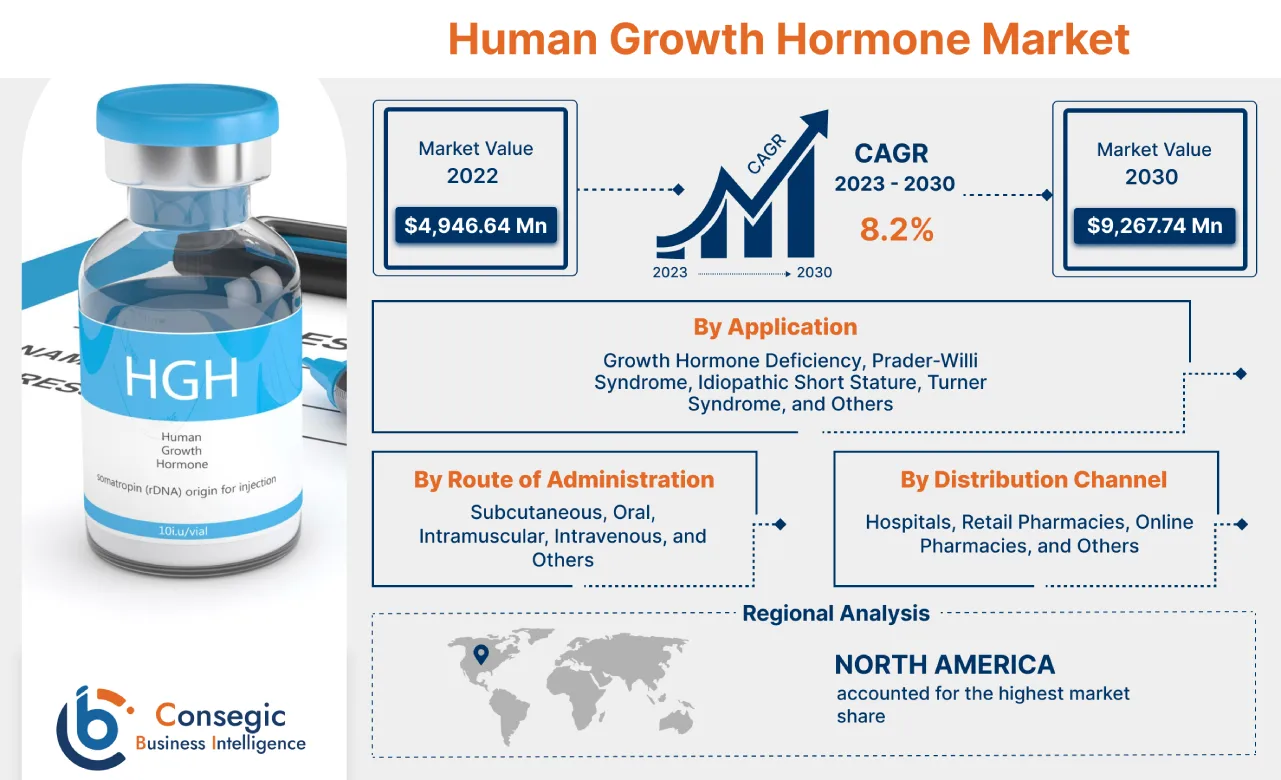Human Growth Hormone Market Size :
Consegic Business Intelligence analyzes that the Human Growth Hormone Market size is growing with a CAGR of 8.2% during the forecast period (2023-2030), and the market is projected to be valued at 9,267.74 Million by 2030 from 4,946.64 Million in 2022.
Human Growth Hormone Market Scope & Overview:
Human growth hormone is a peptide hormone that stimulates growth, cell regeneration, and cell reproduction in humans and further plays a crucial role in overall human development. It is a treatment option for patients who are suffering from hormone growth failure due to an inadequate secretion of endogenous growth hormone. Based on the analysis, it is only effective if administered as an injection. In the current scenario, no pill for growth hormone is available.
Additionally, the release of growth hormone is primarily controlled by two hormones namely, hypothalamus and somatostatin. Hypothalamus is a growth hormone-releasing hormone (GHRH), which stimulates HGH release while somatostatin prevents HGH release.
Human Growth Hormone Market Insights :
Human Growth Hormone Market Dynamics - (DRO) :
Key Drivers :
Rising incidences of growth hormone deficiency are boosting the demand for the market
Growth hormone deficiency (GHD), also known as dwarfism or pituitary dwarfism, is a condition caused by insufficient amounts of growth hormone in the body. Growth hormone deficiency during infancy or later in childhood results in abnormally short stature with normal body proportions. Further, syndromes such as Cushing's syndrome, Turner syndrome, Down syndrome, and Russell-Silver syndrome, among others result in growth hormone deficiency leading to delayed puberty in children. The growth hormone deficiency can be treated by injecting growth hormone with a subcutaneous injection.
For instance, the U.S. Food and Drug Administration approved Sogroya (somapacitan), the first human growth hormone (hGH) injection therapy for adults with growth hormone deficiency.
Hence, as per the analysis, the rising cases of growth hormone deficiency results in increasing demand for novel growth hormone therapies which is the major factor driving the human growth hormone market demand and trends.
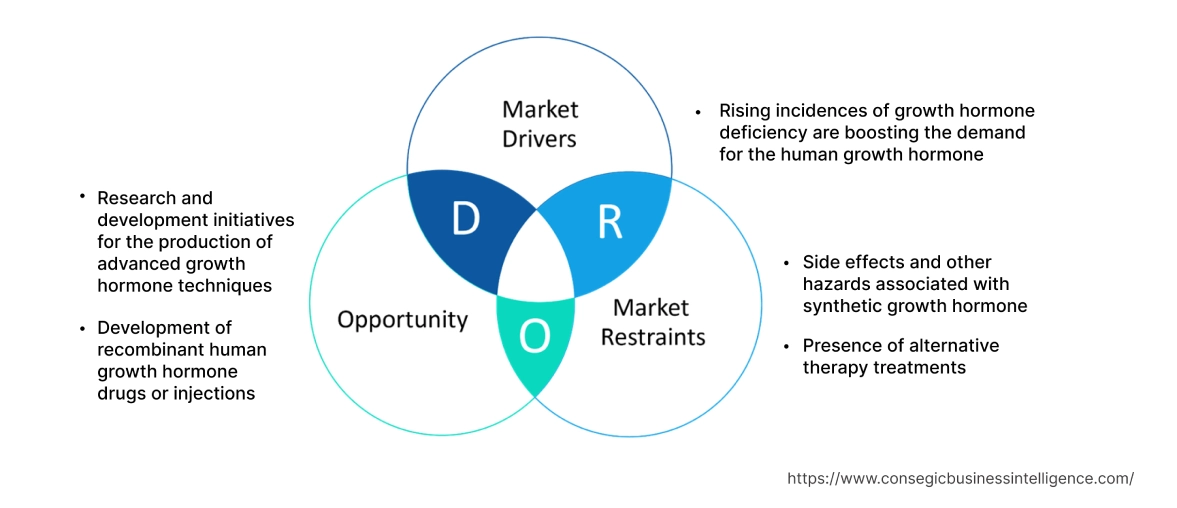
Key Restraints :
Side effects and other hazards associated with synthetic growth hormone
Human growth hormone naturally produced by the pituitary gland spurs growth in children and adolescents. The hormone helps to regulate body composition, body fluids, muscle and bone growth, and sugar and fat metabolism. However, growth hormone produced synthetically is widely used as the active ingredient in several prescription drugs and other products. Further, this growth hormone increases the risk of diabetes and contributes to the growth of cancerous tumors.
Additionally, as per the analysis, the side effects associated with synthetic growth hormone including muscle soreness, joint pain, numbness, and high cholesterol levels, among others coupled with the high cost of therapies utilizing synthetic growth hormones are key factors responsible to hinder the demand and human growth hormone market trend.
Presence of alternative therapy treatments
Sermorelin acetate is a revolutionary prescription drug therapy for increasing growth hormone-releasing hormone (GH-RH). Sermorelin acetate offers all the growth hormone benefits, without the risks or side effects commonly associated with synthetic human growth hormone (HGH).
Sermorelin acetate stimulates the pituitary gland to naturally produce increased amounts of growth hormone. Increased volumes of HGH result in increased production of insulin-like growth factor (IGF-1). These surges result in multiple benefits, most notably improvements in metabolism and cellular growth. Hence, the availability of such substitutes is hindering market demand.
Future Opportunities :
Research and development initiatives for the production of advanced growth hormone techniques
Human growth hormone offers a potential opportunities and treds for the key players to invest in R&D for the production of a growth hormone that has fewer side effects and is a long-acting form of growth hormone treatment.
For instance, Pfizer Inc. and OPKO Health, Inc. introduced NGENLA (somatrogon), a next-generation long-acting recombinant human growth hormone. This is a once-weekly injection to treat children and adolescents 3 or above 3 years of age with growth disturbance due to insufficient secretion of growth hormone.
Hence, as per the analysis, such development of new novel recombinant growth hormones is expected to drive the human growth hormone market opportunities and trends over the forecast period.
Development of recombinant human growth hormone drugs or injections
Recombinant human growth hormones are used to treat growth hormone deficiency. The increasing cases of growth disorders and growth hormone deficiency are providing a lucrative opportunity for the development of advanced growth hormone drugs or injections to restore energy, and metabolism, and enhance body development.
For instance, Ipsen Biopharmaceuticals Canada Inc. launched INCRELEX (mecasermin) for the treatment of growth failure in children and adolescents from 2 to 18 years of age with confirmed severe primary insulin-like growth factor-1 deficiency (SPIGFD). Hence, based on the analysis, the introduction of such types of hormonal drugs or injections is anticipated to boost the human growth hormone market trends.
Human Growth Hormone Market Report Insights :
| Report Attributes | Report Details |
| Study Timeline | 2017-2030 |
| Market Size in 2030 | USD 9,267.74 Million |
| CAGR (2023-2030) | 8.2% |
| By Route of Administration | Subcutaneous, Oral, Intramuscular, Intravenous, and Others |
| By Application | Growth Hormone Deficiency, Prader-Willi Syndrome, Idiopathic Short Stature, Turner Syndrome, and Others |
| By Distribution Channel | Hospitals, Retail Pharmacies, Online Pharmacies, and Others |
| By Region | North America, Europe, Asia-Pacific, Latin America, and Middle East & Africa |
| Key Players | Novo Nordisk, Merck KGaA, Eli Lilly & Company, Pfizer Inc., Teva Pharmaceutical Industries Ltd., Novartis, AnkeBio Co., Ltd, Roche, Ipsen Biopharmaceuticals, Inc., and Genentech, Inc. |
| Geographies Covered | |
| North America | U.S. Canada Mexico |
| Europe | U.K. Germany France Spain Italy Russia Benelux Rest of Europe |
| APAC | China South Korea Japan India Australia ASEAN Rest of Asia-Pacific |
| Middle East and Africa | GCC Turkey South Africa Rest of MEA |
| LATAM | Brazil Argentina Chile Rest of LATAM |
| Report Coverage | Revenue Forecast, Competitive Landscape, Growth Factors, Restraint or Challenges, Opportunities, Environment & Regulatory Landscape, PESTLE Analysis, PORTER Analysis, Key Technology Landscape, Value Chain Analysis, Cost Analysis, and Regional Trends & Forecast |
Human Growth Hormone Market Segmental Analysis :
By Application :
The application segment is divided into Growth Hormone Deficiency, Prader-Willi Syndrome, Idiopathic Short Stature, Turner Syndrome, and Others. In 2022, the growth hormone deficiency segment accounted for the highest market share in the human growth hormone market. Growth Hormone Deficiency refers to the inadequate secretion of growth hormone, leading to stunted growth and other development issues. It is one of the primary indications for growth hormone therapy. Thus, the increasing prevalence of the condition and the necessity of hormone replacement therapy for affected individuals, particularly children is contributing to the human growth hormone market growth and trends.
However, the Turner syndrome segment is expected to grow at the fastest CAGR over the forecast period. Turner syndrome is associated with many complications related to heart, autoimmune disorders, mental health issues, hearing loss, infertility, and pregnancy complications which require treatment involving growth hormones which in turn is expected to boost the market growth and trends.
For instance, according to a research article by Xiaoxiao Cui et al. published in the Intractable & Rare Diseases Research, Turner syndrome (TS) is a relatively common type of human chromosomal aberration that occurs in 1:2,500 live female births and is highly prevalent in China. Hence, the rising cases of Turner syndrome are anticipated to increase the human growth hormone market trends over the forecast period.
By Route of Administration :
The route of administration segment is categorized into subcutaneous, oral, intramuscular, intravenous, and others. In 2022, the subcutaneous segment accounted for the highest human growth hormone market share of 33.87% in the overall human growth hormone market and is expected to grow with the fastest CAGR over the forecast period. The majority of the Growth Hormone Deficiency drugs are administered through the subcutaneous route of administration including Norditropin, Genotropin, Humantrope, Omnitrope, Nutropin, and Saizen. This route of administration is less painful and easier to self-administer which are the key factors boosting the segment growth and trends.
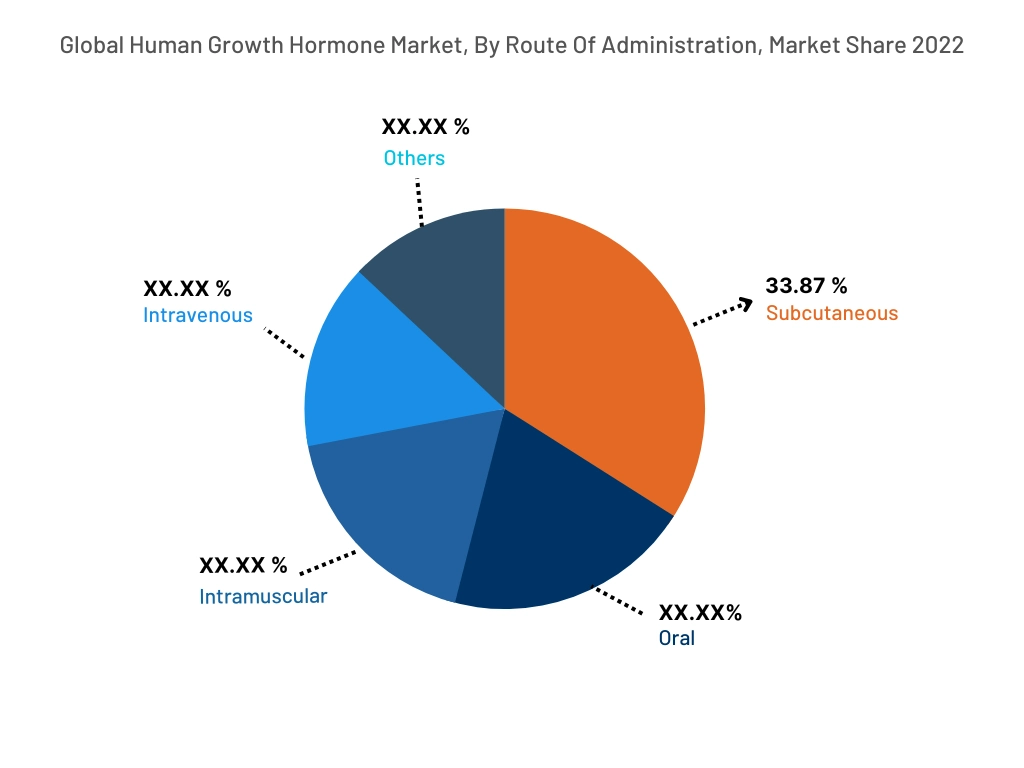
By Distribution Channel :
The distribution channel is divided into hospitals, retail pharmacies, online pharmacies, and others. In 2022, the hospital segment accounted for the highest market share in the human growth hormone market as they have a well-established healthcare infrastructure, specialized medical staff, and the ability to provide comprehensive care to patients, including the administration of HGH.
Further, various HGH prescriptions and treatments are initiated and monitored within hospital settings which is a key factor contributing to the dominance of the segment.
However, as per the analysis, online pharmacies are expected to emerge as the fastest-growing segment during the forecast period due to the increasing growth of e-commerce and digital platforms that facilitated the expansion of online pharmacies, making it easier for patients to access HGH and other medications. Furthermore, the facility of home delivery provided by online pharmacies is also expected to contribute to the trends of the human growth hormone market.
By Region :
The regional segment includes North America, Europe, Asia Pacific, the Middle East and Africa, and Latin America.
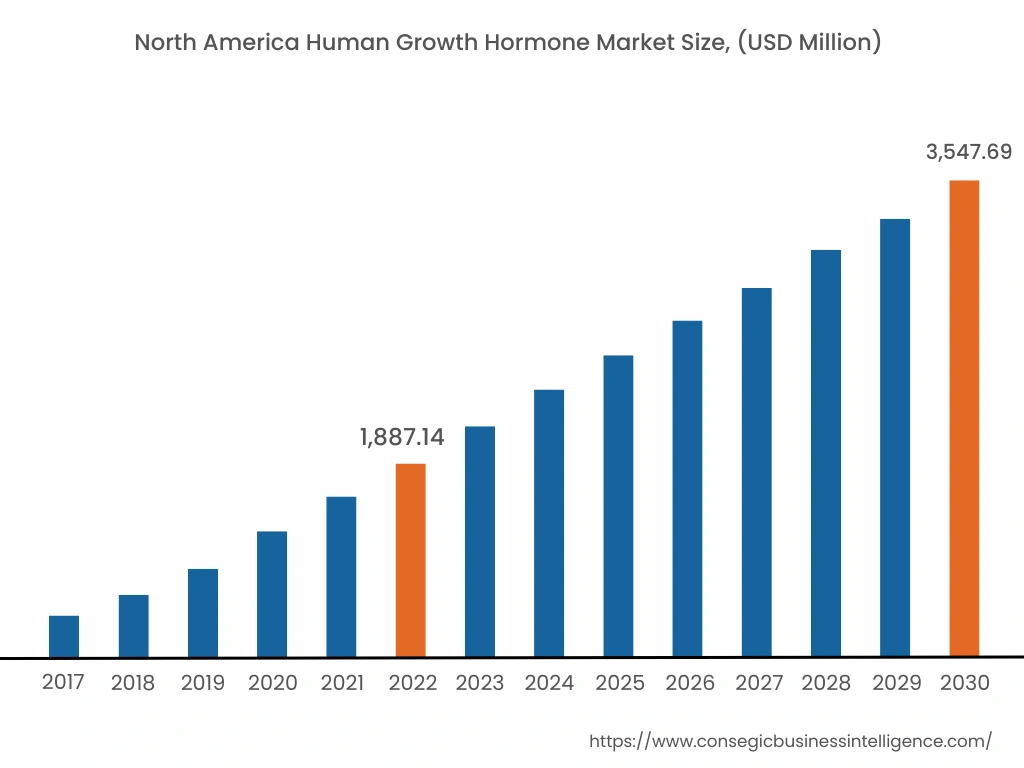
In 2022, North America accounted for the highest market share at 38.15% and was valued at USD 1,887.14 million, and is expected to reach USD 3,547.69 million in 2030. In North America, the U.S. accounted for the highest market share of 65.12% during the base year 2022. Based on the human growth hormone market analysis, the growth is attributed to well-established healthcare systems and increasing awareness about hormone replacement therapies. Further, the key players in the region are engaging in research and development activities for the production of effective growth hormone therapy.
For instance, Novo Nordisk A/S, a U.S.-based company that launched Sogroya (somapacitan) received CHMP positive opinion for expanded use in children and adolescents with growth hormone deficiency for replacement of endogenous growth hormone (GH) in children aged three years and above, and adolescents with growth failure due to growth hormone deficiency. Hence, the introduction of such a type of growth hormone therapy is driving the market growth.
However, Asia Pacific is expected to grow at the fastest CAGR of 8.7% over the forecast period in the market owing to the increasing investment in the development of healthcare infrastructure and a rising number of patients with growth-related disorders.
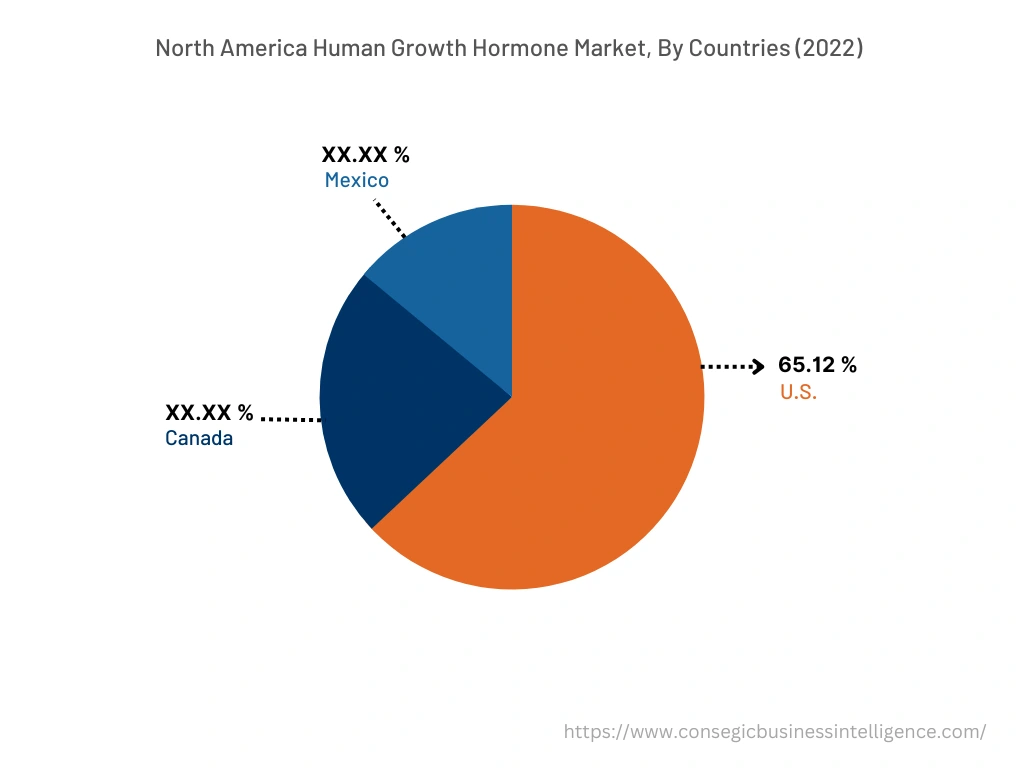
Top Key Players & Market Share Insights:
The global human growth hormone market is highly competitive, with several large players and numerous small and medium-sized enterprises. These companies have strong research and development capabilities and a strong presence in the market through their extensive product portfolios and distribution networks. The market is characterized by intense competition, with companies focusing on expanding their product offerings and increasing their market share through mergers, acquisitions, and partnerships. The key players in the global human growth hormone industry include-
- Novo Nordisk
- Merck KGaA
- Roche
- Ipsen Biopharmaceuticals, Inc.
- Genentech, Inc.
- Eli Lilly & Company
- Pfizer Inc.
- Teva Pharmaceutical Industries Ltd.
- Novartis
- AnkeBio Co., Ltd
Recent Industry Developments :
- In September 2021, BIOCORP and MERCK sign a partnership in the field of Human Growth Hormone (HGH). Biocorp and Merck collaborated on the development and global distribution of a specific version of the Mallya device for applications in the field of HGH.
Key Questions Answered in the Report
What was the market size of the human growth hormone market in 2022? +
In 2022, the market size of human growth hormone was USD 4,946.64 million
What will be the potential market valuation for the human growth hormone market by 2030? +
In 2030, the market size of human growth hormone will be expected to reach USD 9,267.74 million.
What are the key factors driving the growth of the human growth hormone market? +
Rising incidences of growth hormone deficiency are boosting the demand for the human growth hormone.
What is the dominating segment in the human growth hormone market, by route of administration? +
In 2022, the subcutaneous route of administration segment accounted for the highest market share of 33.87% in the overall human growth hormone market.
Based on current market trends and future predictions, which geographical region will have the fastest impact on the human growth hormone market's growth in the coming years? +
Asia Pacific is expected to be the fastest-growing region in the market during the forecast period.
